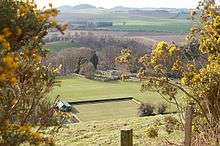Kemback
Kemback is a village and parish in Fife, Scotland, located 2.5 miles (4.0 km) east of Cupar. The present village was developed in the 19th century to house those working the flax mills on the nearby Ceres Burn. From 1681 the minister for the parish was Alexander Edward, until 1689 when he was deprived as a non-juror. He went on to become an architect and landscape architect, working on schemes for Brechin Castle and Hamilton Palace.

The civil parish has a population of 558 (in 2011).[1]
History
The name of the village is from the Scottish Gaelic Ceann Bac meaning 'End of the Corner', from ceann meaning 'head' or 'end' and bac meaning 'hindrance', 'bend' or 'corner', particularly in a field used as a shelter for livestock.[2]
Transatlantic Radiophone Station
- Kemback G.P.O. Transatlantic Radiophone Station (1927–1950s)
In 1927 the General Post Office opened a commercial radiophone service between Kemback and an AT&T site in New Jersey, USA. All that remains (2010) is a metal gate into an open field opposite the Kemback graveyard. The field was originally full of wooden huts, and the hill, and surrounding areas in the parish, were covered in aerials. The civilian GPO services were moved when line of sight was needed for television transmissions during the 1950s.
WWII Secret
Access to most of North Fife was restricted. The Kemback Radio Station was a critical link between Britain and the US, Iceland, Sweden, Norway, and Russia. Classed ULTRA secret, the Kemback station was also needed in the event of a retreat from England, and the loss of the transatlantic cables by the British forces and an equivalent Transatlantic RadioPhone site at Rugby, England. Obviously this eventuality was never needed.
Wartime records of the Station's use for radio interception as part of the network of Y-stations for German Enigma machine transmissions are still restricted, and have not been released into the public domain. It is unclear if the records survive in the National Archives or Bletchley Park.
Several staff based in GPO Kemback were transferred to the Far East in the early days of WW2 to Singapore. Some were captured, and held as prisoners of the Japanese for the remainder of the war.
Medical conditions
The extremely marshy land immediately around the old and new Kemback churches was drained in the 17th and 18th centuries. A local condition called The Drop or The Ague is recorded in the histories of the Lairds of Kemback, and the archive of the Archbishop John Spottiswoode(1565–1639) which, although cannot be confirmed, is probably a form of malaria, similar to that seen in the Somerset levels.
References
- Census of Scotland 2011, Table KS101SC – Usually Resident Population, publ. by National Records of Scotland. Web site http://www.scotlandscensus.gov.uk/ retrieved March 2016. See “Standard Outputs”, Table KS101SC, Area type: Civil Parish 1930
- "Kemback". Fife Place-name Data. Retrieved 3 July 2020.
- "Kemback (Kemback Mills)". Gazetteer for Scotland. Retrieved 2007-06-08.
- Colvin, Howard (1978) A Biographical Dictionary of British Architects 1600–1840, James Murray, pp. 282–3
- New York Times, 1927 (subscription required on website)
| Wikimedia Commons has media related to Kemback. |